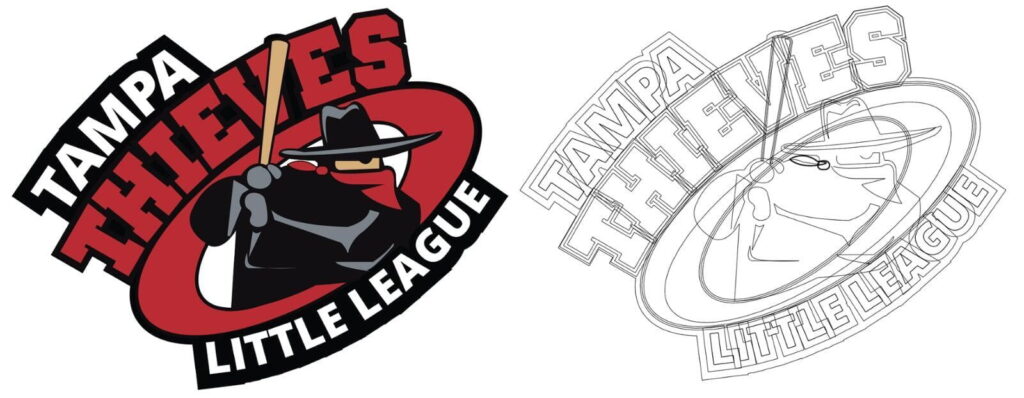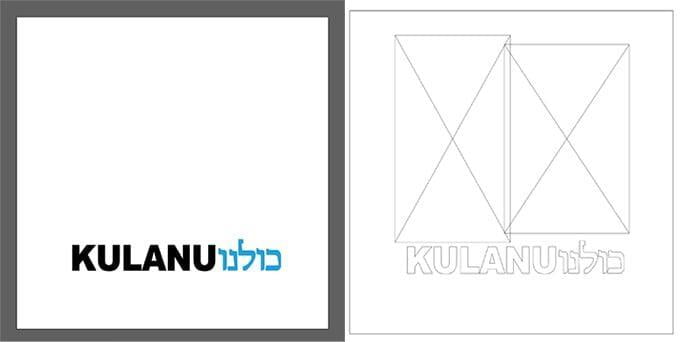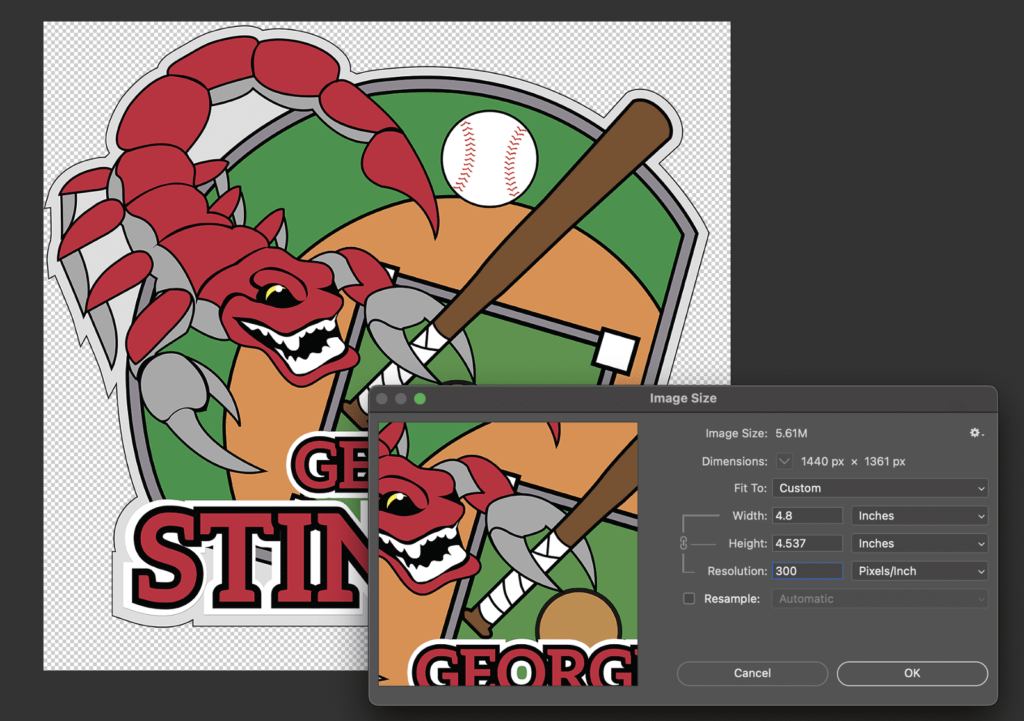Digital Art Lesson 3 of 4: Is my art good quality? (How-To GUIDE)
Welcome back to Digital Art 101!
An ongoing series seeking to answer the most common distributor and end-client questions.
Last time, we discussed the difference between Vector and Raster and how to identify them.
Today, we will go over how to check the art and determine if it is suitable for production. We will be using the Adobe suite programs: Illustrator and Photoshop.
Vector Art: How to prepare for production
To check if your vector artwork is suitable for production, it is always important to open it up in your vector program and view it under outline mode. You can navigate to the VIEW drop-down menu and choose outlines, or select Command+Y (Mac) or Control+Y (PC) to activate it.

However, vector art can sometimes have two common issues which need to be remedied before going to production.
These issues are missing or un-outlined fonts, and/or un-embedded links.
Vector Error: Fonts Missing
Font issues arise when the art still has EDITABLE TEXT, and your personal computer doesn’t have that font in the system. When opening it in Illustrator, you should receive a MISSING FONT ERROR dialog box, and the missing font will be highlighted in pink. In this scenario, it is best to ask the customer to have all text outlined and resubmit the art. Even if the replaced font looks close, the font can be subtly different in a way that is not immediately noticeable.

Sometimes, the font will not be replaced, but the text will show as black text in outline mode (Second example). This means the text is not outlined, but the system was able to find the font. Be extra careful when reviewing and comparing the font to a PDF preview of the art. At this stage, you can select all the replaced fonts and go to the menu and choose TYPE>CREATE OUTLINES. When completed, your font will look like the third example and will be safe to send for production.
Vector Error: Un-Embedded Links
Missing links are becoming an increasingly common issue for vector artwork due to graphic design teams sharing projects and files with each other. By linking a file, the file object will update every time the source image updates in a linked folder. However, when preparing for pre-production, these objects need to be EMBEDDED to ensure they will travel with the file.
When opening a file with an un-embedded link you will receive an error message dialog box warning you of the missing object. Clicking REPLACE will allow you to find the file if you have access to it while choosing IGNORE will allow you to open the file.


Missing links will not show in VIEW MODE. So If you are unsure of what is missing when you fully open the file, viewing in outline mode will reveal a shape with an X through it. When this happens, please ask your customer to provide artwork with all links embedded.
Raster Art: How to prepare for production
When it comes to raster art it is very important to make sure the files meet minimum print quality requirements for your Full color, CMYK, or Digital Print products. This minimum quality is 300 DPI or Dots per inch at inset size.
You will often see terms like DPI, PPI, and Resolution when discussing Raster images, but they all basically mean the same thing. The number of pixels or dots in a single square inch.
For this section, we are going to pretend we are producing a full-color 4” sticker, which means we need art that is at least 4” and 300 DPI or resolution. This process is actually quite simple.

Checking art print quality for 4″ sticker
- Open art in Photoshop.
- Navigate to the menu to IMAGE > IMAGE SIZE.
- Check to make sure the resolution is 300 or above.
- Confirm width and height is appropriate for the inset size of your imprint area. This area often defaults to pixel sizes, just click the dropdown area and choose inches.
Have high-quality artwork that has a large width and height but a low resolution of 72 dpi? If the image is three times larger than you need for the inset width and height, worry not! You can send that artwork in and we can move some pixels around!
Thank you for sticking around for lesson three of our Digital Art Series,
stay tuned for our Blog on “Differences in Color.”
Related Articles
Digital Art Lesson 2 of 4: Checking Art (How-To GUIDE)
Welcome back to Digital Art 101! An ongoing series seeking to answer the most common distributor and end-client questions. Last time, we discussed the difference between Vector and Raster. Today, we will go over how to check the art and identify the ...Digital Art Lesson 4 of 4: Differences in Color (How-To GUIDE)
Welcome back to Digital Art 101, an ongoing series seeking to answer the most common distributor and end-client questions, and today we are discussing colors and how it affects your final product. Below are the previous lessons we have tackled. ...Digital Art Lesson 1 of 4: Vector vs Raster (How-To GUIDE)
Vector vs. Raster Want to sound like an art pro? Distributors and suppliers in the promotional product industry know just how much good quality art is pivotal to a beautiful end product. So with that in mind, read on and stay tuned for our Digital ...Easy Order Guide
Submit your Artwork With a wide variety of products with their own unique Imprinting Techniques IDProductsource wants to make the process of preparing artwork as easy as possible for you. Accepted: Art File Types Usable Art Send us your artwork and ...Encoding Plastic Cards (How-To GUIDE)
Q How do Magnectic Strips work? How do you encode? A Magnetic stripe cards include a magnetic stripe on the back, which are used to encode data. The stripe is comprised of iron particles in a plastic film. They’re often used for credit and debit ...
Popular Articles
Less Than Minimum Formula
Frequently Asked Questions Q We will walk you through the Less Than Minimum Formula (LTM), and how it works. A On the Product Display Page (PDP), if the product states LTM formula applies you can order less than the 1st published increment and price ...Tariff Escalation Timeline
U.S. Tariff Escalation Timeline • February 1, 2025: The Trump administration imposed an initial 10% tariff on Chinese imports. • March 3, 2025: An additional 10% tariff was added, bringing the cumulative tariff rate to 20%. • April 2, 2025: A ...Our Lead Time & Carrier Transit Time (estimated) (How-To GUIDE)
OUR LEAD & CARRIER TIMES Our lead times and product origination are clearly published on our website for each product we offer. (These are subject to change without notice) IDProductsource makes every effort to guarantee ship dates on RUSH PRODUCTS ...Can you Mix and Match Material or Imprint Colors on Lanyards? (Q&A)
Q Can you Mix and Match Material or Imprint Colors on Lanyards? A Yes, you can mix and match both material & imprint colors on a lanyard as long as the imprint itself is staying the same across all of the lanyards. General rule of thumb would be that ...Do you allow Drop-Shipping to different locations? (Q&A)
Question: Do you allow Drop-Shipping to different locations? Answer: Yes, we do allow drop-shipping to different locations with a majority of our products. Split/Drop Shipment: First location is Free + Normal Shipping Costs; Each additional location ...
Recent Articles
Self Promo Suites: Patches
Our Self-Promo Suite is built for distributors. Download, save, and customize with your own logo to promote yourself and your brand. It’s just one more way IDProductsource proves we’re partners—not competitors. Flyer: Social Post: Story:Self Promo Suites: Buttons
Our Self-Promo Suite is built for distributors. Download, save, and customize with your own logo to promote yourself and your brand. It’s just one more way IDProductsource proves we’re partners—not competitors. Flyer: Social Post: Story:Self Promo Suites: Lanyards
Our Self-Promo Suite is built for distributors. Download, save, and customize with your own logo to promote yourself and your brand. It’s just one more way IDProductsource proves we’re partners—not competitors. Flyer: Social Post: Story:Self Promo Suites: Cutting Boards
Our Self-Promo Suite is built for distributors. Download, save, and customize with your own logo to promote yourself and your brand. It’s just one more way IDProductsource proves we’re partners—not competitors. Corporate gifts season is Quarter 4! ...Self Promo Suites: Ornaments
Our Self-Promo Suite is built for distributors. Download, save, and customize with your own logo to promote yourself and your brand. It’s just one more way IDProductsource proves we’re partners—not competitors. Corporate gifts season is Quarter 4! ...